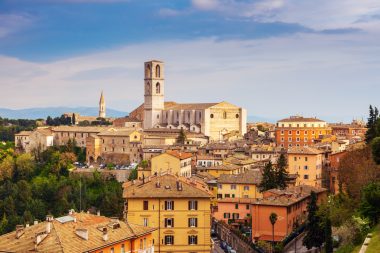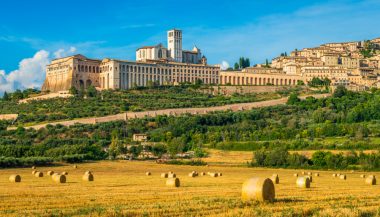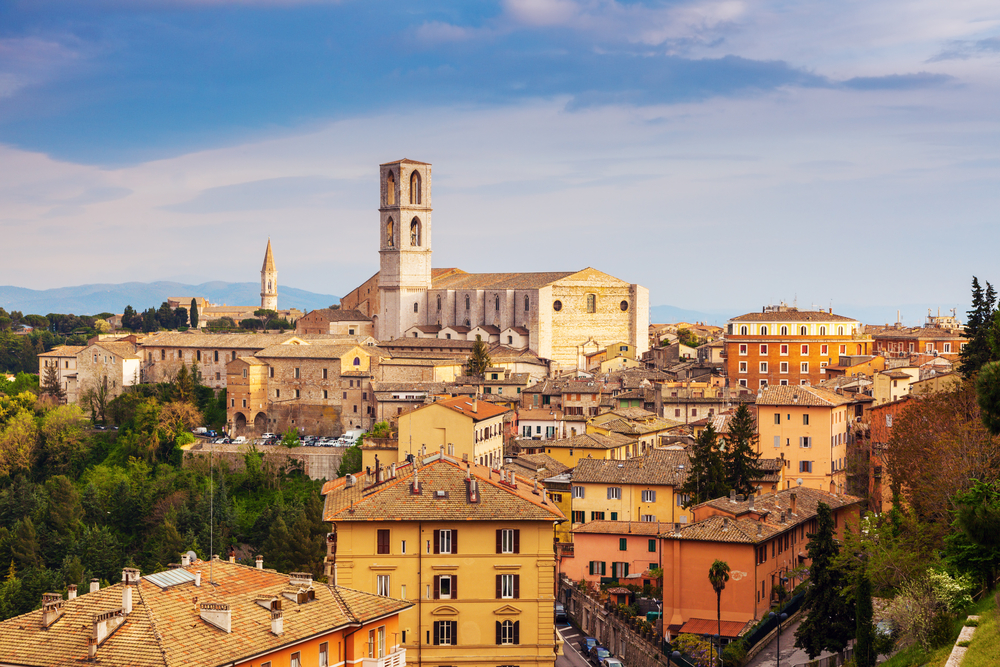Perugia is not only considered the largest, but also the most beautiful city in Umbria. The old town, located on a 450-metre-high hill, offers a view all the way to the mountain ranges of the Apennines. The city of 150,000 inhabitants is rich in history and presents itself as multifaceted, cosmopolitan and full of charm and character.
History at your fingertips
The history of Perugia dates back to the Paleolithic Age. A first settlement existed in today’s city area as early as the 11th century BC. The roots of the city can be traced back to the 6th century BC. At that time, the Etruscans founded the first larger settlement.
Perugia developed into one of the most important cities of the Etruscans thanks to its strategic position. On a tour of the city, visitors can still convince themselves of the former heyday. The historical sights are concentrated along the Piazza Grande.
If you want to learn more about the city’s history, you can do so at Perugia’s Archaeological Museum. In the monastery of San Domenico you can admire ceramics and tombstones from the Etruscan period.
Defiant walls and babbling fountains

The city center is surrounded by two rings of walls. The fortifications built by the Etruscans date back to the 3rd century BC. Furthermore, there was a medieval fortification ring with five city gates, which extended over more than six kilometers.
The Porta Marzia is a preserved city gate from Etruscan times. In the 15th century, another Etruscan city gate, Porta Trasimena, was renovated. At the highest point of the city is the Porta Sole, one of the oldest city gates, which today is also characterized by medieval architecture.
The part of the city wall built by the Etruscans is called Arco Etrusco. In the immediate vicinity of the historic walls, the Fontana Maggiore rises on Piazza IV Novembre, probably the most beautiful fountain in the city of Perugia.
Proud buildings
One of the most important religious buildings in the city is the Cathedral of San Lorenzo. The foundation stone for the church was laid in the middle of the century 14th century. The interior decoration dates mainly from the end of the 15th century. The construction work was completed in 1587 without really having come to an end. One of the most important pieces of decoration is, in addition to the pulpit, a statue of Pope Julius III.
The church of Sant’ Angelo dates back to the 5th century. It is a rotunda. The city’s cathedral was completed in 1490 and is considered a prime example of Gothic architecture. The cathedral also includes an extensive seminar and chapter complex. In 12. and In the 13th century, Perugia hosted five conclaves.
Perugia for art connoisseurs

Art lovers can visit the Galleria Nazionale dell’ Umbria, the most important art gallery in the region. In 2018, the institution celebrated its 100th anniversary. The museum is housed in a Gothic-style mansion.
Visitors enter the exhibition through a richly decorated portal. The interior is dominated by works by Umbrian and Central Italian artists. The treasury houses works by Gentile da Fabbriano or Piero della Francesca. The collection is complemented by Umbrian masterpieces by Pinturicchio and Perugino.
In the adjoining building, the tour continues to the Collegio del Cambio. The medieval exchange office is decorated with numerous frescoes.
City of contrasts
It is not only the numerous students who give the city its very own colour. Perugia can also be explored underground. The path system leads through the foundation of an old fortress and is often the scene of events and exhibitions.
In a city where time seems to have stood still, escalators are less suspected, and yet they also shape the cityscape. Escalators provide the connection between the upper town and the old town. Past a historic backdrop, the path leads up to the historic city center.
In Goethe’s footsteps
At the gates of the city lies Lake Trasimeno, a popular local recreation area. Historically, the water gained importance when Hannibal inflicted heavy losses on the Romans here in 217 BC. The German prince of poets also seemed taken with the water. Goethe is said to have highly praised Lake Trasimeno on his trip to Italy in 1786.
Today, people are drawn to the lake in summer to swim. In winter, the nearby Monte Vettone with its 2,500-metre-high summit is considered a much-visited ski area.
Attention those with a sweet tooth – Perugia in a festive mood
Not to be missed is the tasting of Baci Perugina. The hazelnut pralines produced by the traditional company, which was founded in 1907, are known far beyond the borders of Perugia.
There is even a festival dedicated to sweet seduction. If you travel to Umbria in October, you can attend the Eurochocolate, the festival of chocolate. Those with a sweet tooth will find a wide range of chocolate specialties that can be tasted and serve as popular souvenirs.
Music lovers visit the annual Umbria Jazz festival. National and international artists who have dedicated themselves to jazz or blues perform there.
The surrounding area of Perugia is the scene of the sagre between August and the end of October. The weekly events resemble a harvest festival. The celebrations are usually held in the open air. Regional dishes are served with mushroom dishes, risotto or truffles


